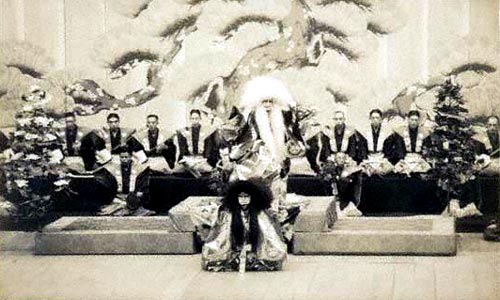| RENJISHI |
| Dance title | Renjishi |
| Author | Kawatake Shinshichi II (lyrics) Hanayagi Jusuke I (choreography) Kineya Sh˘jir˘ III / Kineya Katsusabur˘ II (music) |
| History |
The dance "Renjishi" was staged for the first time in 1861, starring the dance master Hanayagi Jusuke I and his son Hanayagi Yoshijir˘. The music was written by Kineya Katsusabur˘ II and his piece was called "Katsusabur˘ Renjishi". The first performance of this dance with Kabuki actors occured in the 7th lunar month of 1872 at the Murayamaza, starring Band˘ Hikosabur˘ V and Sawamura Tossh˘ II in the roles of the shishi parent and cub. The music piece for this performance was not "Katsusabur˘ Renjishi", but a new piece written by Kineya Sh˘jir˘ III and called "Sh˘jir˘ Renjishi". |
| Key words |
Ky˘genshi Matsubamemono Monju Bosatsu Nagauta Omodaka Jűshu Seiry˘zan Shakky˘ Shakky˘ (N˘) Shakky˘mono Shishi Shishimono Shosagoto |
| Summary |
The theme of "Renjishi" stays close to that of the N˘ play "Shakky˘", and it is classified as a matsubame dance. That is, a dance that's performed before the symbolic backdrop of a large pine tree flanked by bamboo which is copied from the N˘ stage. This scenery has no connection with the dance's content. The first section features a pair of Ky˘gen actors who come to dance the story of the shishi parent and cub. The actors each carry a wooden mask of a shishi head, one with white hair representing the parent shishi and the other with red hair to represent its child. A shishi is a mythological lion-like animal said to be the king of beasts and always associated with the Buddhist deity Monju. For this reason, any portrayal of the shishi should not only bring out its wild, beastial nature, but also a sense of dignity and authority that goes with this divine status. The shishi is in many ways a spiritual creature. The dance is set on a holy mountain in China called Seiry˘zan, among the towering peaks of which there is a miraculous stone bridge spanning a deep ravine. The bridge is a divine manifestation for on the other side is the Buddhist paradise... the land where the deity Monju dwells. The lyrics here are especially magnificent and describe the scenery with such graphic power that one feels truly awestruck. Through the dancers' movements too, the scenery come alive before our eyes. The highlight of this first section depicts the severe physical training the shishi cub must undergo at the hand of its parent. In order to foster courage and strength the parent kicks its young over the edge of the ravine and must wait anxiously to see if the cub can climb back up again. This is said to be a great test of the actor's abilities for he must portray fatherly love as well as a strict sense of discipline. After the two Ky˘gen actors withdraw down the hanamichi, we begin the second section of the dance which is a comic interlude called Shuron ("Religious Debate"). This is patterned after the comic plays of the Ky˘gen theatre which are normally seen in the middle of N˘ plays. In this case, two priests who are on a pilgrimage to Mt. Seiry˘ meet and begin arguing when they discover that they're from different Buddhist sects. Eventually, both become frightened by the darkening skies and by the prospect of coming across the fierce shishi, and they run back down the mountain in a panic. To prepare us for the final scene, the Nagauta musicians then begin a section of ďzatsuma music which is wonderful in its evocation of the grand mountain scenery. There is a short section of slow and gentle drum beats called tsuyu ("dew"), representing single drops of dew falling from the mountain peonies. Then, the spirits of the shishi pair enter. The shishi appear wearing the gorgeous brocade costumes that copy those of N˘ and also have the large trailing wigs made from real yak hair. Their final dance is one of celebration which also expresses the power of these "kings of beasts". Courtesy of Paul M. Griffith |
| Comments |
This dance has come to be staged often recently and is popular for its spectacular ending as well as for the opportunity to see a father and son combination of actors in the leading roles. A special version with one father and 2 cubs was created for Nakamura Kankur˘ and his two sons, Nakamura Kantar˘ and Nakamura Shichinosuke. |
 |
|
A pre-War postcard of the dance "Renjishi" (unknown casting) |
|
|
| Contact | Main | Top | Updates | Actors | Plays | Playwrights | Programs | Links | FAQ | Glossary | Chronology | Illustrations | Prints | Characters | Derivatives | Theaters | Coming soon | News |